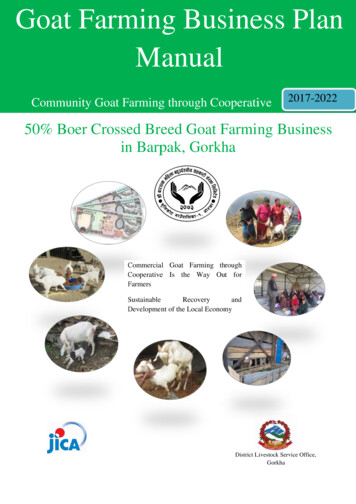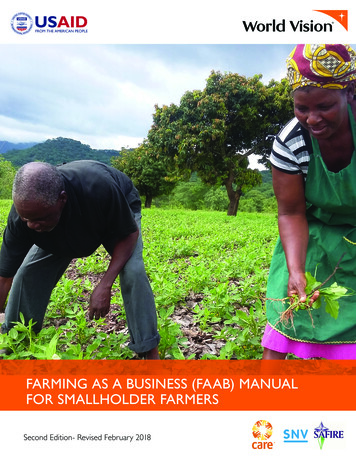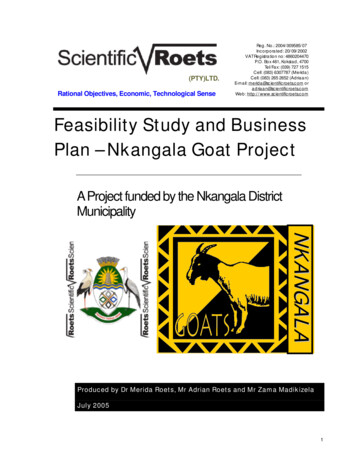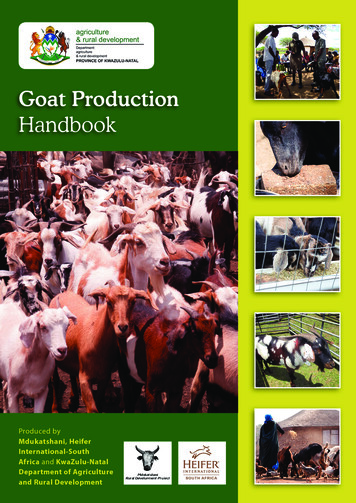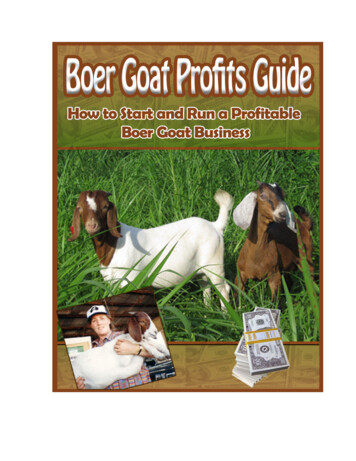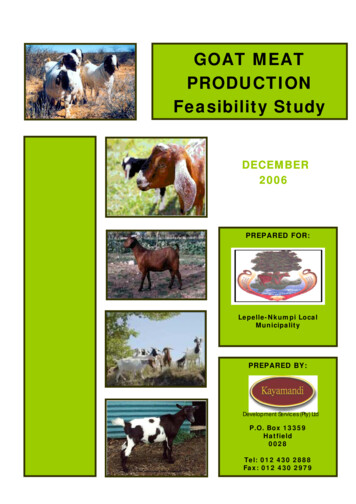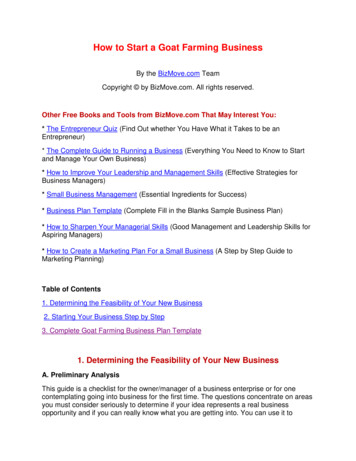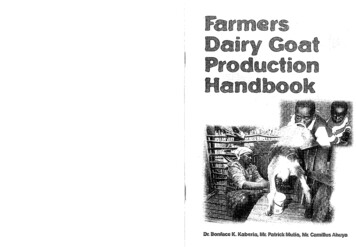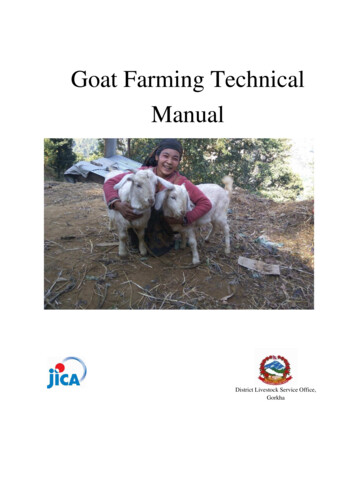
Transcription
Goat Farming TechnicalManualDistrict Livestock Service Office,Gorkha
Goat Farming TechnicalManualDistrict Livestock Service Office,Gorkha1
AcknowledgementThere is highly potentiality for livestock development due to climate and bio-diversityin Nepal. In the country, there is availability of 64 liter milk, 11 kilogram meat and 32 eggs.There shall be increased in the production of 35% milk, 25% meat and 45% eggs in thepresent production, to meet the minimum annual consumption of livestock production as 91liter milk, 14 kilo meat and 48 eggs in the developed country.In this way, there is important contribution of buffalo, goat, sheep, pig, poultry etc. forespecially meat production in livestock production.Likewise, Gorkha district is veryimportant from point of view of goat farming. There are more than 200 thousand goats, andestablishment of nearly 250 commercial goat farms in the district at present. Especially,Jamunapari crossed, Khari crossed, Barbari crossed breeds goats are available here. In therecent time, it has also been started of importing Boer crossed goats in this district. DistrictLivestock Development Office (DLSO) has already developed former Bakrang VillageDevelopment Committee (VDC) and Dhawa VDC as a resource center of Boer goat; whereas,rearing of Boer goat have also been started through Women’s Cooperative in former BarpakVDC (Sulikot Rural Municipality- RM, Ward-1 & 2) from the support of Japan InternationalCooperation Agency (JICA) Nepal from this year.In this way, “Goat Farming Technical Manual” which is suitable and applicable forthe Boer goat farming as well as other goat breeds, is going to be published by JICA Nepal,and this manual shall be very useful to goat farmers in the future. This manual has coveredreproduction, health, feeding, management, marketing and diversified aspects. In this way, itis hoped that this upcoming publishing manual shall be helpful for the development andextension of goat farming business in the district, as it is useful as reference to farmers andstakeholders of this business to set up own business.In addition to, it is very thankful to JICA Nepal for supporting to goat farmingbusiness by publishing “Goat Farming Technical Manual”. Dr. Jagat Bandhu NepaliSenior Livestock Development Officer2
Table of Contents1.INTRODUCTION (BASIC KNOWLEDGE) . 11.1INTRODUCTION OF GOAT FARMING . 11.2CHARACTERISTICS OF GOAT FARMING. 21.2.1 Management (fodder, feed, shed, disease and parasite control) . 21.2.2 Reproduction . 21.2.3 Production and income generation . 21.3IMPORTANCE AND BENEFITS OF GOAT FARMING . 21.4IMPORTANCE OF COMMERCIALIZATION OF GOAT FARMING . 41.5BREEDS OF GOATS REARED IN NEPAL . 51.5.1 Local breed . 51.5.2 Foreign goat breeds reared in Nepal . 71.5.3 Hybrid goats in Nepal . 91.6FEEDING MANAGEMENT FOR GOATS . 10101.6.1 Feeds of goats and habits of searching feed . 10101.6.2 Feeding Management for smaller kids . 11111.6.3 Feeding Management for adult goats . 11111.6.4 Methods of preparation of balanced feed by using local raw materials . 12121.72.TAGGING KIDS FOR IDENTIFICATION . 1313MANAGEMENT OF GOAT SHED . 13132.1INTRODUCTION OF FARM SHED/BARN . 13132.2IMPORTANCE OF SHED . 14142.3PLAN FOR CONSTRUCTION OF GOOD SHED . 14142.4CONSTRUCTION OF GOAT SHED . 15152.4.1 Locally available resources while constructing goat shed. 15152.4.2 Area required for goats . 15153
2.4.3 Sample of Shed . 16162.4.4 Improtant things to be considered in shed management. 19193.4.PLAN FOR FEEDING SAFETY . 19193.1BASIC FEEDS FOR GOATS. 20203.2FEEDING METHOD. 2323REPRODUCTION / BREEDING MANAGEMENT. 24244.1INTRODUCTION TO REPRODUCTION OF GOATS . 24244.1.1 Major signs of does in heat . 24244.1.2 Reproduction Age (For Boer Cross). 25255.4.2REPRODUCTION WITH DIFFERENT KINDS OF BREEDS . 26264.3RECORD KEEPING FOR REPRODUCTION/BREEDING . 2727MANAGEMENT OF BUCK AND DOE . 27275.1IMPORTANCE AND INTRODUCTION OF BUCK AND DOE MANAGEMENT. 27275.2FEED AND HOOF MANAGEMENT FOR BUCK . 27275.3IMPORTANCE AND INTRODUCTION OF REMOVING INBREEDING IN GOATS . 28285.4MANAGEMENT OF BUCK IN ROTATION FOR REMOVING INBREEDING . 28285.5RECORD KEEPING . 29295.5.1 Record keeping of every doe . 29295.5.2 Record keeping for each buck . 30306.HEALTH AND NUTRITION MANAGEMENT . 30306.1HEALTH: INTRODUCTION AND IMPORTANCE . 30306.1.1 Methods of recognizing sick and ailing goats . 31316.1.2 Tasks to keep the goats healthy . 32326.2MAJOR DISEASES IN GOATS . 32326.2.1 Bloat in goat . 32326.2.2 Diarrhea (Loose feces). 33334
6.2.3 Pneumonia . 33336.2.4 Hoof rot. 34346.3IMPORTANCE OF TRIMMING HOOVES AND TRIMMING METHODS . 34346.4ATTENTION BE GIVEN TO HEALTH OF GOATS . 35356.5OBSERVATION OF HEALTHY GOATS . 36366.5.1 Teeth condition of goats based on its age . 36366.5.2 Identifying health condition of goat observing goat dunk. 37376.5INTRODUCTION OF NUTRITION IN GOAT FARMING AND IMPORTANCE OF APPROPRIATENUTRITION . 38386.6REQUIRED NUTRITION FOR KIDS, ADULT AND PREGNANT DOE . 38386.6.1 Pregnant and parturition goat . 38386.6.2 Method of feeding newborn kids . 39396.6.3 Goat weaning management . 39396.6.4 Buck management . 40407.6.7METHODS OF FEEDING. 40406.8CHANGING FEEDS . 4141PARASITE CONTROL AND VACCINATION FOR INFECTIOUS DISEASE 41417.1PARASITES . 41417.1.1 Internal parasites . 41417.1.2 External Parasites . 44447.2IMPORTANCE OF IMMUNIZATION AND SCHEDULE . 45457.2.1 PPR . 45457.2.2 Foot and Mouth Disease (FMD):. 46468.MANAGEMENT OF GRASS PRODUCTION AND HARVESTING . 47478.1INTRODUCTION OF GRASS . 47478.1.1 Different kind of grasses. 47475
8.2IMPORTANCE AND BENEFITS OF GRASS . 48488.3METHOD OF FARMING (SOWING AND PLANTATION), LAND PREPARATION ANDHARVESTING . 48488.3.1 Farming period . 48488.3.2 Selection of grass . 48488.3.3 Nemaro (Ficusroxburghii): . 49498.3.4 Raikhanyu (Ficuscunica) . 50508.3.5 Ipil Ipil (Leucaena leucocephala) . 51518.3.6 Napier grass (Pennisetum purpureum) . 51518.4GRASS CUTTING AND STORAGE . 53538.4.1 Introduction: Grass cutting and storage . 53538.4.2 Importance and benefit of grass storage . 54548.4.3 Method of Silage making . 54548.4.4.9.Method of preparing hay. 5656MANAGEMENT OF KIDS AND PREGNANT DOE . 57579.1PREGNANT DOE MANAGEMENT (BEFORE PARTURITION) . 57579.2CARE TAKING DURING PARTURITION OF DOE . 57579.2.1 Problems faced at the time of parturition . 59599.3CARE TAKING AT POSTPARTUM . 60609.4MANAGEMENT OF KIDS . 61619.4.1 Creep feeding for kids . 61619.4.2 Creep feeding . 62629.5CASTRATION OF MALE KIDS . 62629.6WEANING OF KIDS . 63639.7SEPARATION OF WEANED KIDS . 646410.SELECTION OF GOATS. 64646
10.1INTRODUCTION AND IMPORTANCE OF GOATS SELECTION. 646410.2METHOD OF SELECTION . 656510.3SELECTION OF GOATS FOR REPRODUCTION/BREEDING . 666610.3.1Selection of breeding buck. 666610.3.2Selecting of doelings . 676710.3.3Points to be considered while purchasing buckling and doeling . 676710.4SELECTION OF GOATS BASED ON CONDITION . 676710.5REMOVAL OF UNPRODUCTIVE DOES . 686810.5.1 Condition for removal of doe . 686810.5.2 Keep following doe for breeding:. 686810.5.3 Importance of doe removal . 696810.6EFFECTIVE UTILIZATION OF CROSS-BREEDING . 6969REFERENCES. 707087
Goat Farming Technical Manual1. Introduction (Basic knowledge)1.1Introduction of goat farmingGoat is a multi-use animal which is commonly reared for the meat (chevon). In thedifferent parts of the world, goat is raised for the meat, milk, wool and leather. Goat isalso called “the poor man’s cow”. In Nepal, the goats can be reared in differentecological zones; hence, people are adopting goat farming as an enterprise. Sheep andgoat are belonging to different species, but their management is almost similar. InNepal, almost in all parts, sheep and goats are raised. And, as all caste and ethnicpeople like goat meat; day-by-day, goat farming has become a popular business. Forthe goat farming, the meager needs of fodder and fewer requirements of feedscompared to rearing other livestock, goat farming requires low investment. Shedmaking can also be possible in a low cost, and easy to sell goats in the case of needsarises to farmer. So, the goat farming enterprise is in growing trend.Figure No. 1.1.1 Commercial goat farmingSource: JICA Project TeamLivestock farming consists of one third share of total agricultural Gross DomesticProducts (GDP) in Nepal; thus, it contributes a major share in agricultural system. Asper data source of Department of Livestock Services, Fiscal Year 2073/74; there are10,986,114 goats in Nepal. Similarly, 65,583 metric tons of goat meat is producedwhich is 20 per cent of the total meat produced.1
As the goat farming business can be operated through a low investment, it has givenopportunity of employment and income generation to small farmers and women.Therefore, goat farming has become a boon to poverty alleviation. The amount offeed and fodder necessary for one cow can be easily reared for 5-6 goats; and farmershaving less land can easily raise 2-4 goats.1.2Characteristics of goat farming1.2.1Management (fodder, feed, shed, disease and parasite control)After purchasing goats, an entrepreneur needs to manage shed construction as per thesuitable to climate, nutritious feeding, treatment of diseases and vaccinations, controland timely treatment of goats from internal and external parasites.1.2.2ReproductionAfter ensuring appropriate management of doe, it becomes ready for reproduction.The mating should be ensured that parturition does not fall in the month ofAshad/Shrawan (July/August) and Poush/Magh (November/December), as it wouldbe difficult to take care of new born kids.1.2.3Production and income generationAfter 5 months of mating, kids are produced, and income generation will be readyfrom selling after rearing 8-10 months.1.3 Importance and benefits of goat farmingMeat production: Goat meat consists of 20.3% of the total meat produced in thecountry and the demand is ever in increasing trend.Fig. No. 1.3.1 Fresh meatSource: JICA Project Team2
In goat meat (chevon); We can find— 76.8% water— 2.6% fat— 19.6% protein and— 1% mineralsAs, comparatively low quantity of fat and high protein, goat meat isconsidered beneficial to health. Can be operated in low investment: In comparison of starting other livestockfarming, interested small farmers can start with goats. Goats farming can bringopportunity of income generation at home for the small farmers with lowinvestment at small space. PEWA (Ownership): To create, the work environment at family, traditionallygoats and kids are given as Pewa (Ownership) to daughters and women familymembers. In this way, temptation for making Pewa has promoted positively togoat farming. Transformation of fodders into nutritious protein: Comparatively goats can bereared with lesser amount of feeds than swine and chicken. Goats eat normalforage, fodders and store in its body as meat which is full of protein. Coping of needs: Goats can be soldat any time, and thus has helped tomeet the needs of cash. Return in short time: As the goatshave capacity to give birth of morethan one kid at a time, and threetimes in the period of two years, itgenerates quicker income in shorttimewithlowinvestmentcomparison of rearing other cattle.inFig. No. 1.3.2 Compost making fromgoatSource: JICA Project Team3
Rearing goats for milk and wool: We are raising goats mainly for the meat. But, inappropriate climate and management, goat farming can be done for the milk andwool. Compost fertilizers for crops: Livestock are integral part of agriculture. Goatfarming has a major contribution in providing fertilizers to crop production. It hasreduced the dependency to chemical fertilizers and enhanced the productioncapacity of the land. Goats are needed for traditions or festivals: In our traditions of celebratingDashain and meeting commitmentsto God and Goddesses with offeringofbucksanddoes,goatsareconsidered inevitable livestock. Fortransportation:InpartsofHimalayan and Hill-belts where forgoats)Sinhal and Chyangra have been inuse.Fig. No. 1.3.3 goats used fortransportationSource: JICA Project Team1.4Importance of commercializationof goat farming To create opportunity of self-employment to human resources, youths and women,who remains wastage in country; and to enhance their self-respect throughappropriate management To increase income generation through scientific goat farming in traditionalapproaches To reduce a large volume (corers of rupees) import of goats from neighboringcountry Most people from different religious sects love chevon, and demand of goat’smeat is in increasing trend in country, which is only possible to meet withadequate supply through commercialization.4
1.5Breeds of goats reared in Nepal1.5.1Local breedBreedGoatsLocal breeds of goats(native)Geographical distributionTeraiTerai BeltKhariInner Hill BeltSinhalHigh Hill BeltChyangraMountainous Belt(A) ChyangraChyangra is reared above 2,500 metersin the mountainous region. Hairs areused for making Pashmina. Usually itgives birth once in year. Its averageweight is 27-30 kg. Doe and buck’sweight is 35-40 kg. Bucks can carrygoods almost 30% of its weight.Fig. No. 1.5.1.1 Chyangra breed goatSource: Commercial Goat Farming, CentralSheep and Goat Promotion Office(B) SinhalIn high hill belt, 1500-2500 meters,Sinhal goats are raised. Its color isbrown,whiteandblack.DoeSinhal’s weight is up to 34 kg andbuck’s weight is up to 42 kg. Thisgoat produces one kid at a year; andannually it gives around 200 gramsof rough hairs.Fig. No. 1.5.1.2 Sinhal breed goatSource: JICA Project Team(C) KhariFrom 300 to 1500 meters of altitude Khari goats are reared. Khari goats are indifferent colors and it is usually called hilly or AULE (low land) goats. Doe usuallyweighs 15-25 kg and buck weighs 25-35 kg. These Khari gives its first birth inaverage 16 months of age. Stature of its body is smaller and smarter; Khari can be5
reared by keeping in bond or bygrazing. Among local breeds of goatsin terms of numbers, Khari goats areraised in many numbers in hilly belt ofNepal. Keeping in views of climate,immunity from diseases and averagegrowth, Khari goats are regarded usefulin the belts of hills and inner hills ofFig. No. 1.5.1.3 Khari breed goatNepal.The characteristics of Khari goats areSource: Central Sheep and GoatPromotion Officegiven as below: Can give 3 times birth during 2 years of intervals Less suffering through diseases, compare to foreign breeds imported in Nepal,Khari has more immunity towards diseases Can be reared in normal shed Generally, one goat gives birth at time 2 kids Can graze in slopes Balance feeds are not necessary Mortality rate of kids are low Meat is tasty and tight(D) Terai goats:Terai goats are reared in Terai belt ofNepal. Doe weighs up to 18 kg andbucks weigh up to 32 kg. And, if wellmanaged, it can give 3 times birth within2 years. In average, there are 2 kids at atime of birth.Fig. No. 1.5.1.4 Terai breed goatSource: Central Sheep and GoatPromotion Office6
1.5.2Foreign goat breeds reared in Nepal(A) BoerBoer was developed in the SouthAfrica, and it can be reared in alltypes of climate. Boer breed hasmore immunity to diseases thanthe local breeds, and can give100% twin birth; and within twoyears, it can give 3 times birth.Adult Boer weighs more than 100kg, and if it crosses with localKhari breed, weighs 35-40 kgFig. No. 1.5.2.1 Boer breed goatSource: JICA Project Teamwithin a year.In 2065 BS, Boer had been reared for detailed research in Goat Research Center,Bandipur. Now, in different parts of Nepal, Boer has been commercially reared byleader farmers. In comparison of other breeds, maturity of Boer is quicker. Before andafter separation of milking, the growth rate of Boer kids, in both conditions, is 150300 grams per day.(B) BarbariBarbari has small and robust body,short and standing ears, red or brownpatches in white body and does notfeel interested in grazing, thus itwould be better to rear as a stallfeeding system. It is reared for bothpurposes- meat and milk. The adultBarbari doe weighs 20-25 Kg andbuck weighs 25-40 Kg. In average,kids weigh 2 Kg at birth.Fig. No. 1.5.2.2 Barbari breed goatSource: JICA Project Team7
(C) SannenSannen was originatedoriginated in Switzerland, and it isis best suitable to rear at cold than hotclimate. It is famousfamous for milk production throughout the world,world, this goat breed ispolled (hashas no horn naturally),naturally) ear areflopped towards front side,side andd haswhiteandsmallhairs.Afterparturition, this goat gives milk for150-180180 days resulting in average600-700 liters of milk production.Normally, it gives birth in a year andgives a kid per birth. Doe weighs upFig. No. 1.5.2.1.5. 3 Sannen breed goatto 68 Kg and buckbuck weighs up to 91Source: JICA Project TeamKg in average.(D) BeetalIt seems to be like Jamunapari breeds,and it is reared for milk and meat.meat. It isbelieved that Beetal originatedginated inPunjabjab and Hariyana of India. It hasfeatures like wide and medium builtbody, raised nose, backward andoutside bound horn, flat and hangingears, short and thin tail; and it hasas alsogood quality skin.skin Adult buck weighs60-70 kgg and doe weighs 46 kg; and kidFig. No. 1.5.2.4 Beetal breed goatSource: JICA Project Teamweighs 3 Kg weightwei t at the time of birth.8
(E) SirohiThis goat breed has originated at dryplace of Sirohi, Rajasthan, India andimported in Western parts of Nepal.Sirohi has tight body,body, and are good formeat. It has physical characteristics likerough hair; short and pointed nose; flat,long and weaker ears; sharp, upward andbackward faced horns. At time of birth,kids weigh 2.5-2.752.5 2.75 Kg; whereas,whereas, buckweighs 50--7070 Kg and doedo weighss 25-35Kg at lives.Fig. No. 1.5.2.51.5. Sirohi breed goatSource: JICA Project Team(F) JamunapariHuge body, long leg, centrally ridgednose (parrot like nose), hanging logears, short and flat horns are majorphysical features of this goat. AdultJamunapri buck weighsweigh up to 45 Kgand doe weighsweigh 38 Kg. At birth, kidsweighs up to 4 Kg in average.Fig. No. 1.5.21.5.2.66 Jamunapari breed goat1.5.3 Hybrid goats in NepalSource: JICA Project Team Boer cross (Khari and Boer) Jamunapari cross ( Khari and Jamunapari: Khapari)Kh Barbari cross (Khari and Barbari: Khabari) Sannen cross (Khari and Sannen)9
(A) Introduction of Boer cross (Khari xBoer)Boercrosshasbeendevelopedcrossbreeding between in pure Kharidoe and pure Boer buck. The crossbreedof Boer can survive in any types ofclimate. Boer cross has comparativelybetter immunity towards diseases.Fig. No. 1.5.3.1 Boer cross breed goatSource: JICA Project Team(B) Why we need Boer cross? Boer cross has been reared up to 2100 meters high altitude and its growth is goodin mid-hill belts. Boer cross can be reared by both ways: reared in stall feeding or open grazing. Boer cross acclimatizes in all types of weather. As adult Boer weighs up to 100 Kg, its cross breed can also be found with heavyweight. Both goats breed can give 3 times birth within two years of interval and havecapacity to give twin kids. Both Boer and Boer cross goats have tasty and compact meat. Before and after lactation in both conditions it has higher growth rate in kids andlow mortality rate. 1.61.6.1High immunity towards disease is found in Boer cross.Feeding Management for goatsFeeds of goats and habits of searching feedGoats have larger belly comparatively to other cattle, and can eat smaller grasses whichother cattle cannot. Goats can also eat bitter grasses. Goats can eat dry matterequivalent of 4% of its own body weight. Goats can produce more meat, milk by takingsubstandard grass than other cattle. Goats do not like to eat wet and filthy things.10
1.6.2Feeding Management for smallerkidsOffspring needs to be fed with milkfor 2-3 times in a day so that kids canbe protected from diseases. After twoweeks, progeny can have soft grassand feeds. Kids must be weaned fromits mother after 10-12 weeks, and1.6.3feed more forage and feeds withFig. No. 1.6.2.1 Feed feeding at paddockprotein.Source: JICA Project TeamFeeding Management for adult goatsAfter 4 months of parturition, Doeling and Buckling should be kept in separate frompreventing unnecessary mating behaviors from bucks to doeling. It is necessary thatgrowth of Boer cross kids should be50-150 grams per day; if it is notmeasured, it should be learnt that thereis a problem in feeding management.As possible as for the whole 24 hours,green forage and fodders should bekept in the place of stall. Salt andother multi-nutrients minerals cakeand clean water adequately needs tobe fed to goats. Diet of goats and kidsbased on its weight has been given asFig. No. 1.6.3.1 Concentrate feeding to adultgoatsSource: JICA Project Teamfollowings:11
Table No. 1.6.3.1Necessary feed of goats based on its weightWeight of goatMilk intakeConcentrate feed Green fodder(kg)(ml per day)(gm. per day)(kg per day)22400335004600560050as much as 0250“10300350“15200350“20350about 2kg)30350about 4kgmore than 30400about 5kgSource: Central Sheep and Goat Promotion Office, Harihar Bhawan1.6.4Methods of preparation of balanced feed by using local raw materialsTo obtain cheap feed is an important element for getting profit from any livestock,and as much as 50% cost is incurred in Goat Farming. Healthy livestock’s can beproduced by ensuring proper quantity and balanced feeding. To obtain maximumbenefit, focus to be given in fodder plants than into feeds. Crops (non-leguminous) – 3 parts(different varieties of crops like maize, wheat,bran-roughage, products from maize, wheat, millet, rice, etc.) Pulses (Leguminous) or wastages from oilseeds (bi-products): 1 part By mixing crops and legume or different types of pina very well, balance feedcan be prepared. If dry bi-product of oilseeds is avilable, it is necessary to break in small particals,and better to be roasted, but it is not necessary if it is fed after cooking.12
Likewise, it would be better to mix 1 kg sa
Goat is a multi-use animal which is commonly reared for the meat (chevon). In the different parts of the world, goat is raised for the meat, milk, wool and leather. Goat is also called “the poor man’s cow”. In Nepal, the goa ts can be reared in different ecological zones;
